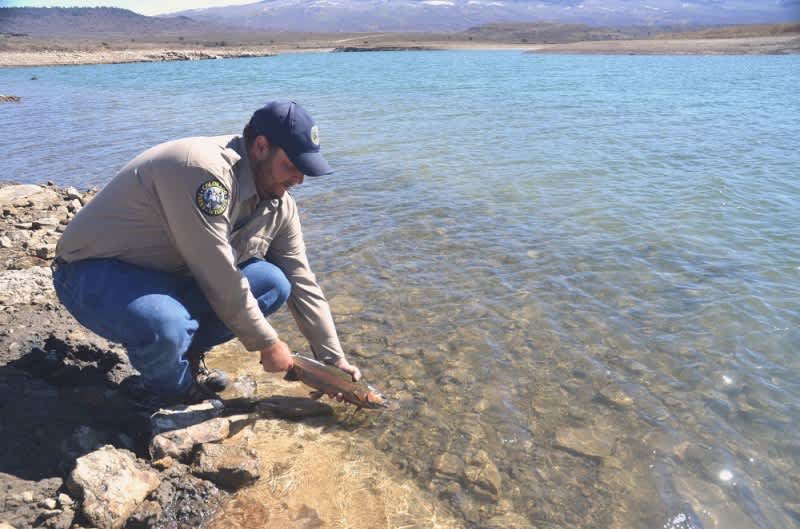Fish Restocked at Colorado’s Miramonte Reservoir
OutdoorHub 10.21.13

Miramonte Reservoir is ready for anglers again. Nearly 100,000 trout were stocked into the lake on Oct. 17-18 by Colorado Parks and Wildlife, completing a critical aquatic reclamation project that cost more than $100,000.
The 400-acre reservoir is now open to fishing, and by next summer anglers will be seeing many fish that are up to 14 inches long. Ice fishing this winter should be productive for the freshly stocked trout.
To give the reservoir fishery a jump start, Parks and Wildlife stocked 210 large brood-stock trout–all more than 20 inches in length, 15,000 catchable size rainbows 10 inches in length, 10,000 5-inch brown trout, and 70,000 fingerling rainbow trout that are 3 inches in size. This major stocking operation provides an immediate trophy component and also provides the reservoir with plenty of fish of various sizes that will grow quickly.
Eric Gardunio, aquatic biologist in the Montrose area, said that Miramonte will quickly regain its status as one of Colorado’s most outstanding still-water fisheries.
“Miramonte Reservoir is a trout-growing machine, growing fish at up to 9 inches a year,” Gardunio said. “We expect the fishery to rebound quickly and great opportunity for anglers will return soon.”
Crayfish were unaffected by the treatment and are plentiful at the reservoir.
Anglers are reminded that all regulations are again in effect at Miramonte. The daily bag limit is four trout, possession limit is eight.
Colorado Parks and Wildlife conducted a chemical-treatment operation on Sept. 10 to remove smallmouth bass that had been placed in the reservoir illegally sometime before 2011.
The bass threatened the Miramonte trout and crayfish fishery, and native fish downstream in the San Miguel and Dolores rivers.
“The treatment operation went very well and follow-up testing indicated that all fish in the reservoir were eliminated,” Gardunio said.
Reservoir surveys early this summer showed that bass, a predator fish, likely had a negative impact on the popular trout fishery. The reservoir was last stocked with trout fingerlings in the spring of 2012. But biologists didn’t find smaller-sized trout that would have matched that year class. Biologists suspect that the bass consumed many of the fingerlings. During the summer, anglers also reported catching only low numbers of large trout.
“This sampling supported our concern that the smallmouth bass would consume the fingerling trout which would result in a future crash of the trout population if the bass were not removed,” Gardunio said.
The surveys also showed that Miramonte is not well suited for bass. The species quickly became the dominant species in the reservoir. But most of the bass grew to only 6 to 12 inches in length, indicating that the population could become stunted due to the short growing season, the cold water of the reservoir and the high competition for food among the growing population.
Despite the fact that the reservoir is not suited for a warm-water fish species, Parks and Wildlife officials are concerned that someone might put bass in the water again. Illegal stocking is a major problem in Colorado and throughout the West.
“Illegal introductions of fish into our reservoirs are one of the biggest issues facing the management of angling opportunities,” said Renzo DelPiccolo, area wildlife manager in Montrose. “Misguided, greedy actions by a minority of anglers are causing law-abiding anglers throughout Colorado to lose opportunities like at Miramonte Reservoir. These actions are also consuming large amounts of our agency’s time and money which reduces the quality of management in other fisheries.”
The Miramonte clean-up project cost the state and partnering agencies more than $100,000, required six months of intense planning, and closed the reservoir to recreation for more than a month.
Colorado Parks and Wildlife is increasing monitoring effort at all fisheries that could be stocked with invasive species like smallmouth bass.
“We are encouraging anglers to be vigilant and to report any suspicious activity that could indicate illegal introductions,” DelPiccolo said. “We still believe that there are good folks out there who will come forward with information on the illegal stocking of Miramonte. We are offering a reward. But more than that, reporting suspicious activity is the right thing to do. We need to hear from you.”
In addition to increased monitoring of fisheries by Parks and Wildlife law enforcement and responsible anglers, the agency has worked with researchers at Colorado State University to develop technology to trace the origins of illegally introduced fish.
“We now have the ability to virtually ‘fingerprint’ a reservoir, lake or pond. So we know where an illegally stocked fish comes from,” Gardunio said.
With these new tools Parks and Wildlife can gather important evidence that will lead to more thorough investigations of illegal stocking activity. Individuals caught moving fish between waters are not only responsible for paying ticket fines to the state, but they can lose their fishing privileges and be pursued in civil court for the costs of expensive reclamation projects.
“Rest assured that Colorado Parks and Wildlife is committed to preventing situations like Miramonte from happening in the future,” DelPiccolo said.
To report suspicious or illegal activity regarding Miramonte or anything to do with wildlife, call Operation Game Thief at 1-877-265-6648. Information can be provided anonymously. Rewards are possible for informants who provide tips that lead to convictions.
For more information about fishing in Colorado, see: cpw.state.co.us.

